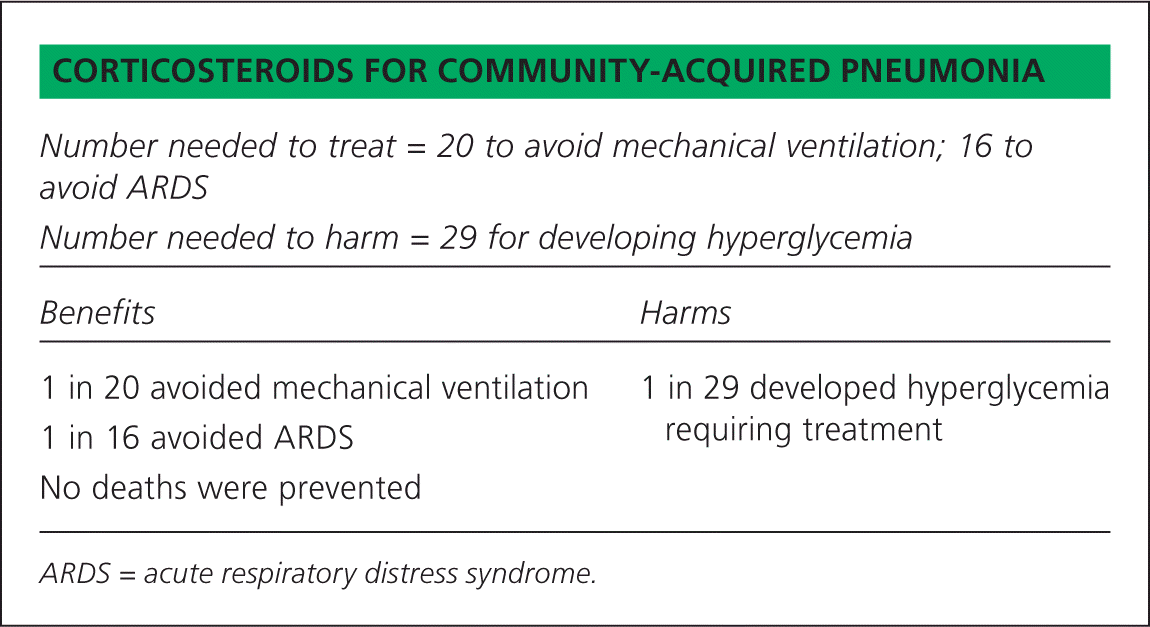
Am Fam Physician. 2016;93(11):online
Author disclosure: No relevant financial affiliations.


| Number needed to treat = 20 to avoid mechanical ventilation; 16 to avoid ARDS Number needed to harm = 29 for developing hyperglycemia | |
|---|---|
| Benefits | Harms |
| 1 in 20 avoided mechanical ventilation | 1 in 29 developed hyperglycemia requiring treatment |
| 1 in 16 avoided ARDS | |
| No deaths were prevented | |
Details for This Review
Study Population: Adults with community-acquired pneumonia (CAP)1
Efficacy End Points: All-cause mortality; need for mechanical ventilation; rate of acute respiratory distress syndrome (ARDS); length of hospital stay
Harm End Points: Hyperglycemia requiring treatment; gastrointestinal bleeding
This review summary assesses the benefits and harms of systemic corticosteroids in hospitalized patients with CAP. Patients received placebo or systemic corticosteroids ranging from a single dose to 10 days of treatment. Twelve studies of 1,974 patients demonstrated no statistically significant reduction in mortality, although there was a trend toward mortality reduction: 7.9% in the placebo group and 5.3% in the corticosteroid group (relative risk [RR] = 0.7; 95% confidence interval [CI], 0.5 to 1.0). Five studies of 1,060 patients demonstrated a 5% absolute risk reduction (number needed to treat [NNT] = 20) in mechanical ventilation (RR = 0.5; 95% CI, 0.3 to 0.8), whereas four trials of 945 patients demonstrated a 6.2% absolute risk reduction in ARDS (NNT = 16; RR = 0.2; 95% CI, 0.1 to 0.6). Effects appeared to increase with the severity of pneumonia. Corticosteroids also reduced time to clinical stability and discharge (mean difference = −1.0 day; 95% CI, −1.8 to −0.2 days). In terms of adverse effects, six trials including 1,534 patients demonstrated a 3.5% absolute increased risk (number needed to harm = 29) of hyperglycemia with corticosteroid use (RR = 1.49; 95% CI, 1.01 to 2.19).
Caveats: The trials compared different corticosteroid preparations, doses, routes of administration, and durations. All but one study used multiple-day regimens (most used seven to 10 days). Moreover, varying proportions of patients in each trial had chronic obstructive pulmonary disease, a condition known to benefit from corticosteroid use. Based on problems with allocation concealment, blinding, and other methodology elements, eight of 13 trials were at high risk of bias.
No large, multicenter, methodologically rigorous trials on this topic have been published, making results inconclusive. Small trials like the ones included here have significant potential to exaggerate effects, suggesting that large, well-designed trials have the potential to override the findings in this review. In the meantime, a trend toward mortality benefit, improvements in two patient-oriented outcomes, and no major patient-oriented harms established thus far suggest it may be reasonable to use corticosteroids in patients with CAP while awaiting further data.
This series is coordinated by Dean A. Seehusen, MD, MPH, AFP Contributing Editor, and Daniel Runde, MD, from the NNT Group (theNNT.com).
A collection of Medicine by the Numbers published in AFP is available at https://www.aafp.org/afp/mbtn.
This review is available from the NNT Group at http://www.thennt.com/nnt/corticosteroids-community-acquired-pneumonia/.
